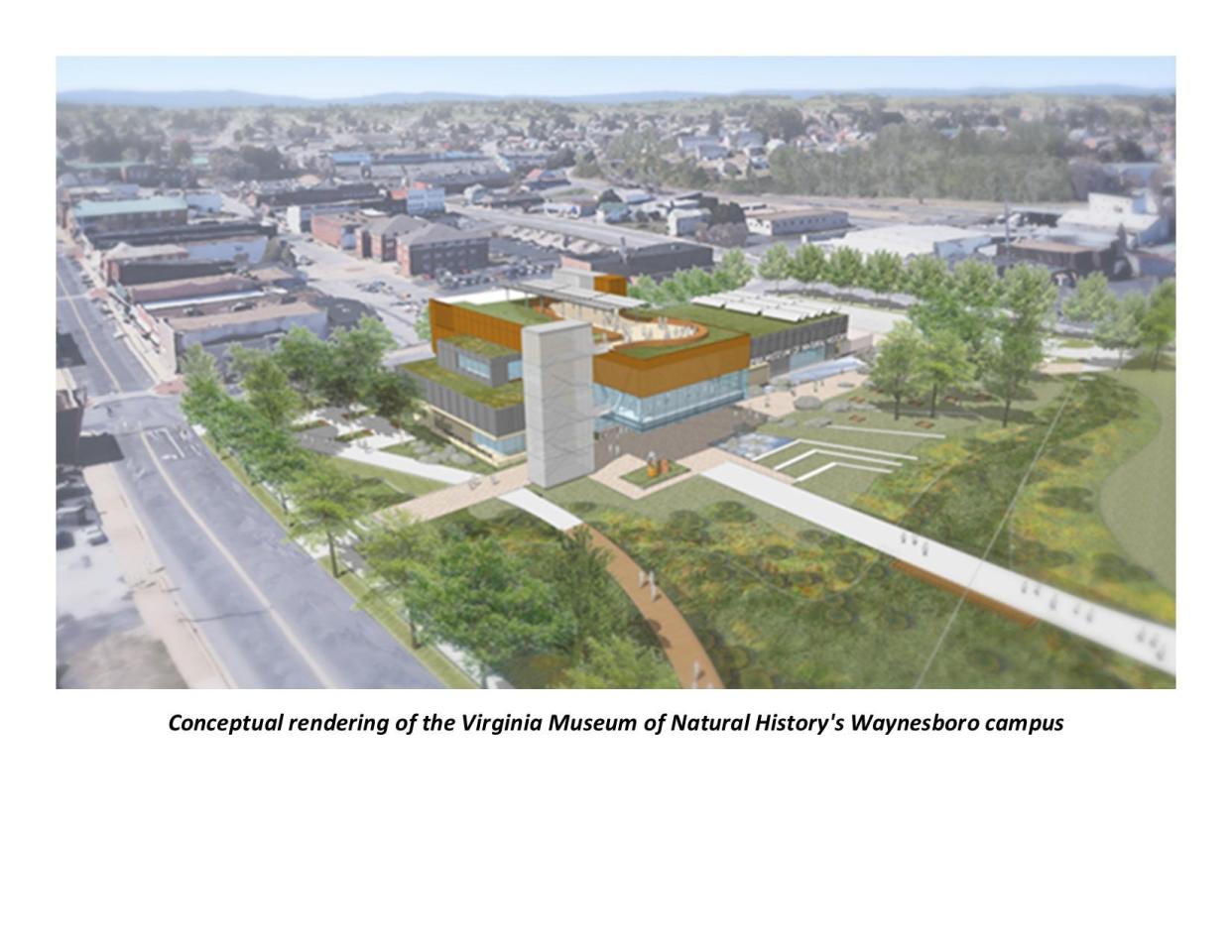Waynesboro's natural history museum still two years out

WAYNESBORO — The Virginia Museum of Natural History's Waynesboro campus is set for groundbreaking in 2024, according to a release from the museum.
Currently in the design phase, the updated timeline includes updated drawings planned for release in late 2022, design completion in 2023 and a tentative groundbreaking the following year, the release said. The museum has partnered with Glavé & Holmes Architecture, out of Richmond, to create the designs of the new facility and follow the construction project through to completion, per the release.
The museum will be located at the corner of West Main and Arch streets near the South River.
"This is an exciting development that signifies a new chapter in the VMNH-Waynesboro campus project," said Dr. Joe Keiper, executive director of VMNH, in a release. "Glavé & Holmes Architecture has an outstanding track record of delivering incredible results for numerous cultural, educational, and civic institutions throughout the Commonwealth. We have the utmost confidence that, together, we will deliver a museum facility that will be an asset and place of pride for the entire region."
During this stage of the project, preliminary conceptual drawings will be updated with detailed designs that will address every aspect of the construction project, including the final appearance of the facility, the release said.
The Waynesboro facility will be approximately 28,000 square feet of space — 20,000 of which will be dedicated to exhibit galleries and children's learning and play areas, the release said. It will also include multiple classrooms, a science laboratory and will provide a direct connection to the South River, the release said.
Museum officials have worked closely with regional educators, colleges and universities, conservation organizations and other community stakeholders to make sure the new museum branch benefits the entire region, the release said. That level of collaboration will remain a priority during the design phase, according to the release.
"In the coming days, museum officials and regional stakeholders will meet with our newly formed team of architects, exhibit designers, landscape specialists and others to ensure that our lofty vision for the new VMNH-Waynesboro campus is fully realized," Keiper said in the release. "We're excited to begin this process and look forward to continuing our engagements with the community in the weeks and months ahead."
Last year, the Waynesboro campus had been included in Virginia’s budget, which allowed the museum to move forward with detailed design work and exhibit experience of the new museum facility in downtown Waynesboro.
A few years ago, the projected total cost to construct and equip the Virginia Museum of Natural History-Waynesboro was estimated at $22 million with portions of that money coming from a financial incentive package from the city, state and private fundraising and possible capital funding from the state.
In 2018, Waynesboro City Council approved a $1 million incentive, which includes direct financial contributions, in-kind support and real property and is contingent on the additional financial support from the state of not less than $7 million for the construction of a new building in downtown Waynesboro.
A feasibility study found that the museum would serve the entirety of Virginia, with a core service area of 11 cities and counties in the Shenandoah Valley, stretching from Rockbridge County north to Rockingham County and east to Albemarle County.
Between 45,000 and 85,000 visitors would be expected to utilize the facility each year, according to the council memo. The total annual economic impact was estimated to be $2 million.
Specific features of the facility would include:
Exciting, creative exhibits interpreting the local environment and natural history using some of the 10 million artifacts currently housed in Martinsville
Environmental classrooms supporting Science, Technology, Engineering and Mathematics (STEM) education and providing an opportunity for some 63,000 K-12 students in the region to explore and learn
A playscape interactive area for early childhood learning
Publicly viewable laboratories where curators and university partners will have an opportunity to work and learn
A resource for partners in public programs and scientific research that will include the Wildlife Center of Virginia, James Madison University, and the Department of Game and Inland Fisheries
VMNH is the state’s museum of natural history, dedicated to interpreting the natural and cultural heritage of the Commonwealth in a way that is relevant to all citizens.
The idea for establishing an interpretive center focused on natural resources can be traced back to the first Virginia Fly Fishing Festival initiated by Waynesboro Downtown Development Inc. in 2000. It is a direct outgrowth of their vision and significant contributions from the Shenandoah Valley Chapter of Trout Unlimited and Dominion Energy to build the education pavilion in Constitution Park, as well as the efforts of the Center for Coldwaters Restoration, a volunteer citizen group formed in 2010.
For more information about VMNH-Waynesboro, visit vmnh.net/projects/waynesboro-campus.
More:Bread days expands to restaurant; Art in the Park; Staunton Pride — The buzz
More:Staunton man who injured officer with car sentenced to federal prison
More:Riverheads and Waynesboro opened up the football season Friday. Check out our photos
Laura Peters is the trending topics reporter at The News Leader. Have a news tip on local trends or businesses? Or a good feature? You can reach reporter Laura Peters (she/her) at lpeters@newsleader.com. Follow her @peterslaura. Subscribe to The News Leader at newsleader.com.
This article originally appeared on Staunton News Leader: Waynesboro's Virginia Museum of Natural History to break ground in 2024

